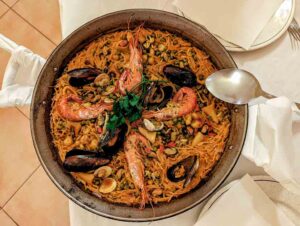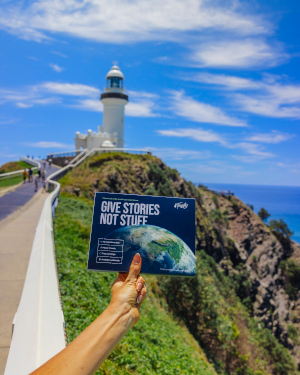It was time to visit the brother and his wife again. So we packed our bags and off we went to Mallorca, Spain for a month. The days passed so swiftly that there was hardly enough time to cross off all the places on our things to do in Mallorca list.
But we had covered a decent number of top sites to visit on our holidays in Majorca. So if you’re headed that way, here’s a list of cool Mallorcan places to visit.
Things to see and do in Majorca aka Mallorca, Spain, according to yours truly
Stay on an active sheep farm

Mallorca is not just beaches, caves, and mountains. It is also farms and vineyards. And many of these farms open their doors to guests via Airbnb or other websites. Skip the hotel, stay on a farm.
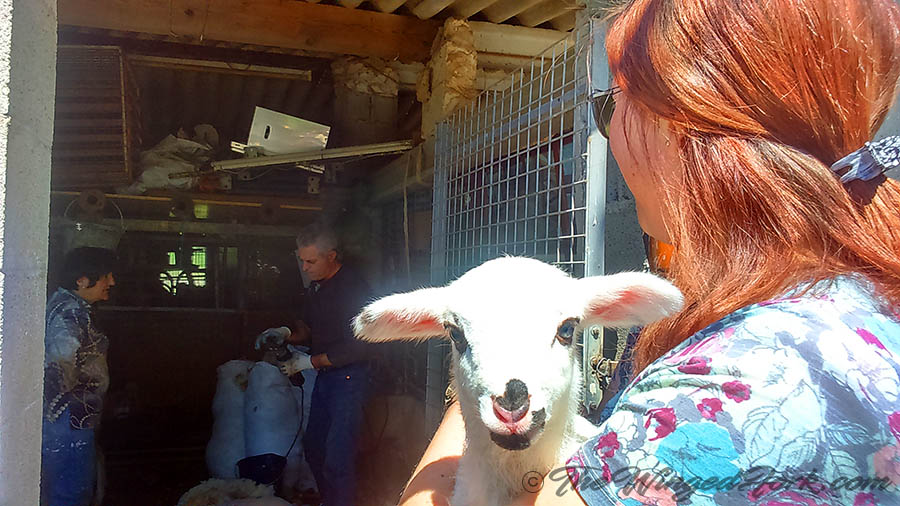
We were lucky because the place that we rented is actually a small but active sheep farm. In three weeks, we got the chance to watch the sheep being sheared, play with labradors, and carry newborn lambs, and so much more. It was well worth it!
We also spent time idly watching sheep try to eat lemons. Yeah, I have a few videos of that actually. It’s like the fox and the grapes story, except the sheep gets the lemon and then realizes its sour. I don’t know why; I just found it fascinating.
The difference between visiting the happening towns or cities and visiting these off the beaten path places in Spain is really big. People are relaxed, they have more time to chat, you see a different lifestyle.
If you ask us to choose, we’d pick the hidden side of Mallorca over the crowded beaches or cities like Madrid and Barcelona any day. But of course, if you are headed to Madrid for a visit, my friend Lauren has lined up a great walking tour of Madrid.



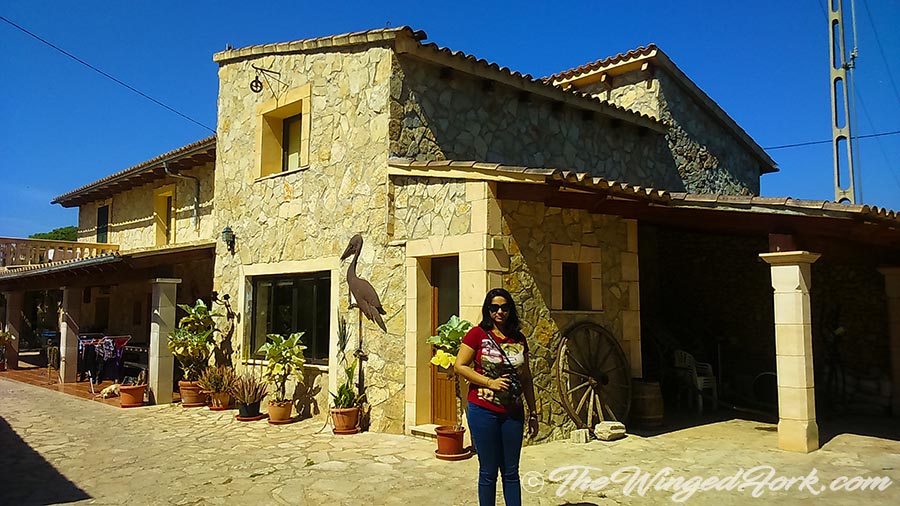
I also took a lot of pics of my host’s house. If you want to stay with them, ping James and his family at jaiancb@gmail.com or call Jaume at +34629918583 If you prefer to stay in Inca town, they have a place there too. Nope, I’m not an affiliate. We’re friends. Just tell him Aaron’s sister Abby told you about his place 😉
See the world’s largest rose window
The La Seu or Palma Cathedral or Cathedral of Santa Maria of Palma is a Gothic Cathedral that was built by King Jaume of Aragon in 1229 after he was saved by a storm at sea.


It’s famous for housing the world’s largest rose window that filters the beautiful light streaming in. You can stare at it for hours! This 13th century Gothic Cathedral is one of the main stops on cultural and historical tours of Palma de Mallorca.
We went on our own, but you cna also join this tour and many other really nice day trips that covered the top things to do in Majorca. There’s an option of everything from affordable hop-on hop-off bus tours to guided tours, cooking classes, sailing trips, and market runs.
You should use local guides to get the info right from the horses mouth. Click here to see what things to do in Mallorca through Musement or Viator!




There’s not enough open space between the Cathedral entrance and the building opposite it. So it’s difficult to get a good shot of the front. I was almost lying on the ground to get this view.

The view of Palma bay from just outside the Cathedral is absolutely lush.

But the best view of La Seu is from across the other side of the fountain. So if you get there, don’t forget to go over to the other side.
Stumble across an old World War II Bunker

Cala Mesquida is one of the most beautiful beaches in Mallorca.

Most people who visit Cala Mesquida go there enjoy the warm waters and white sandy shores that stretch nearly 300 metres long lined with beach umbrellas. But if you look back to it’s history, you’ll find out that the Cala Mesquida was one of the largest strongholds on the island for smuggling tobacco and coffee. Interesting.

And if you walk to the South East end of the Cala Mesquida beach, a little bit to the right, you’ll find what we found. An old abandoned World War Two bunker from General Francisco Franco’s regime that’s in ruins, but definitely one to tell your folks about.
It was later used by the Spanish Military during World War II in fear of an invasion from the Allies, and is supposedly still under protection of the Spanish military.

General Franco is the Spanish Nationalist who ruled Spain almost as a dictator from 1939 to 1975. This of course, was after the Spanish Civil War that lasted from 1936 to 1939.
The bunker in question is one of many along the coast of Spain, built using locally available material for camouflage under the authority of honorary general Ricardo Fernández de Tamarit.
He was responsible for the construction of the Tamarit Line, a series of bunkers and camoflauge nests along Mallorca’s North-Western coast. There are estimated to be 200 along the entire coastline of historic Spain constructed at locations where beach landings were possible; but only 100 have been documented so far.

This bunker at Cala Mesquida was outlined with loose stones, and can hardly be seen from the sea. It has two openings that could be used to shoot in different directions.

The guns and rifles may have long been silenced, and the bunker is no longer in use. There’s a bit of garbage dumped inside. But it’s still a reminder of what could have happened in times of war.
It would have been easy to go down into the bunker, but might have been difficult to get out of without something to step on. So we didn’t attempt it.

It seems that earlier on, the sand from the beach was mined and taken away by builders. The whole Cala Mesquida area is part of a nature reserve that’s been protected since 1991, along with the neighbouring Cala Agulla. More seagulls and cormorants are seen here than in other parts of the Balearic Islands.

The beach is surrounded by the pine forests of the Capdepera Nature Reserve that has over 21 hiking routes.
Eat a Majorcan Paella made by a true Majorcan

Now, if you go to Spain, you might find paella everywhere. But you need to scope out the paella’s made by the real locals, the people that have were born and bred there. Be it a restaurant or someone’s home, paella made by a true Majorcan will always taste different and a whole lot better than someone else’s version of paella. Go find yourself some!
By the way, if you’re not in the mood for local food, and want something regular, you’ll just as easily find some burgers or pizzas locally.
Visit a miraculous Castle that’s still under excavation
Just 7 km away from Cala Mesquida is the little town of Capdepera. The Castell de Capdepera, founded in the 14th century, sits on a cliff atop the village. It was built by the king’s decree in order to protect local residents from pirates.
It may not be as grand as the Alhambra in Granada, but it does have an interesting history. By the way, here’s the perfect 3 day itinerary for Granada by a friend of mine.

Up until the 16th century, over 125 families were housed inside its walls; but since then it became a military fortress and all the residents have moved outside the walls.
We can only see the foundations of the old houses. Some are still being excavated. There are a lot of artefacts stored in the Castle Museum.
Capdepera Castle was abandoned in 1856 and became government property in 1983.


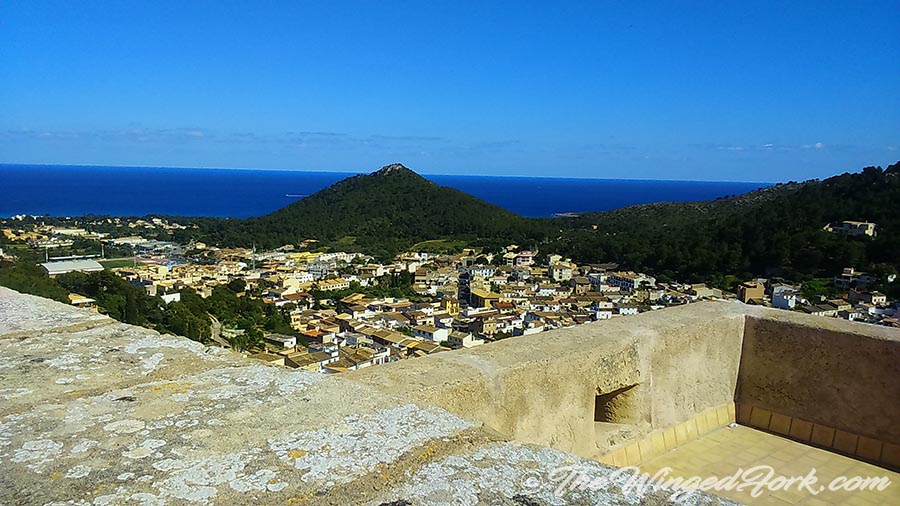

Legend has it that during a siege, placing an image of Our Lady of Hope on the castle battlements resulted in a miraculous fog that drove the Moslem invaders away.
This miracle is recorded inside the Capel de Nostra Senyora de la Esperança and celebrated at the festival every year.
At present, Capdepera Castle overlooks the little town and provides stunning views of the surrounding country side and the sea. The Capdepera Treaty signed by King Juame I in 1231 with the Saraceans is the oldest treaty in existence.
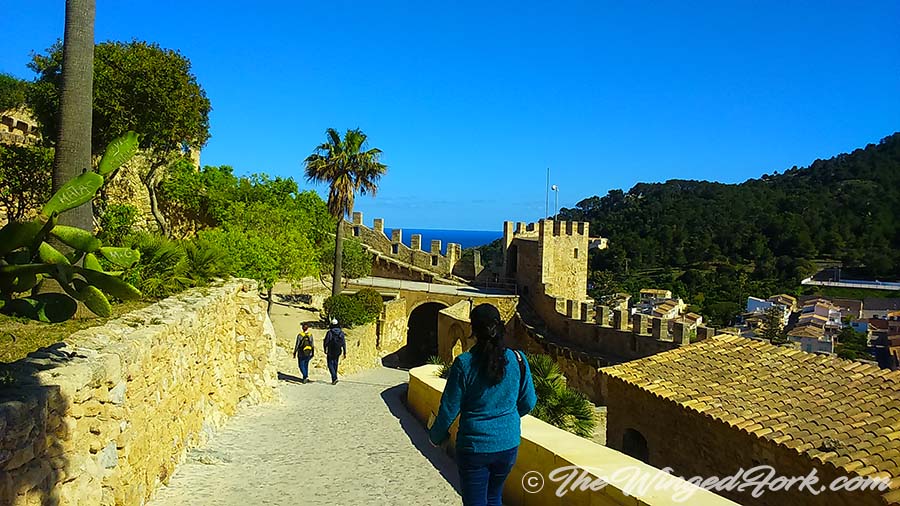
Just remember that you can only drive part of the way up the slope to the castle. You, have to walk up the rest of the way to the castle. And it’s a slightly steep climb, somewhere between 30 to 45 degrees. So it’s best to avoid it on sunny days. Go earlier in the day if you can, although it’s only open from 9 AM to 5 PM.

You can also walk the ramparts of the Castle. Here’s my brother going ahead of me.

On a side note, if like me you love amazing views, there’s an amazing one from the ladies loo at the Castle. This pic above is what I got from there!
Test your driving or riding skills on the serpentine Tramuntana
We drove along serpentine roads that test the driving skills of even the best drivers and give the fastest riders something to work for.
Okay, we didn’t test our own skills. I don’t even have a license yet. Grew up in a country where travel is mostly done by train and rickshaw. We tested my sis-in-law’s skills. And I must say, she’s awesome!
But these roads in the Tramuntana mountains are not for the faint of heart. And you’re rewarded with the smell of pine forests and groves of olive trees all through your drive up and down hill to the Calobra area. When you get there, you first reach the Sa Calobra beach which is different from the one I’ll tell you about in a bit.
The Sa Calobra beach is perfect for swimming, snorkeling, and boating. In fact, many tourists get here by boat from the neighbouring Port de Soller. The beautiful blue waters will make it difficult to leave.
The area has restaurants and cafes and many ice cream stalls to cater to the visitors.
See the opening scene of Cloud Atlas! Or rather the location of the opening scene

Do you remember when the lawyer Adam Ewing meets Dr. Henry Goose at the start of Cloud Atlas? That 2012 movie has been profound on so many levels that one cannot watch it only once. I’ve watched it a few.
To recreate that scene in your mind’s eye, visit this small pebble-covered beach at Sa Calobra. It’s located at the end of the Torrent de Pareis and can be accessed via a tunneled walkway through a cliff.
Even though the beach is pebbled, it’s still easy to sit or lie down on because the pebbles are quite small in size.

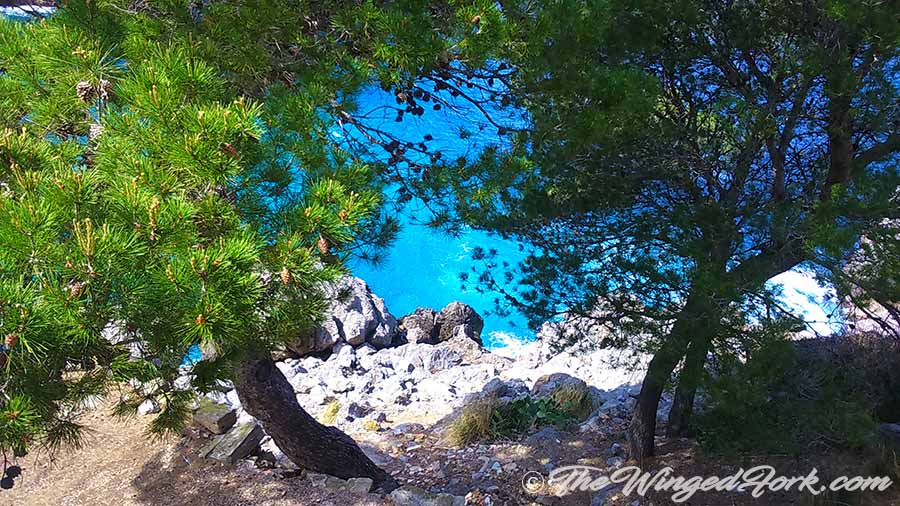


This hidden cove beach is perfect for a swim and also perfect for some seclusion if you get there before the crowds do. The best time to visit during summer is from 7 am to 11 am. After that, it gets quite crowded.
By the way, Sa Calobra is also one of the most instagrammable spots on Mallorca. A must-visit, when it’s not crowded.
See one end of the famous Torrent de Pareis
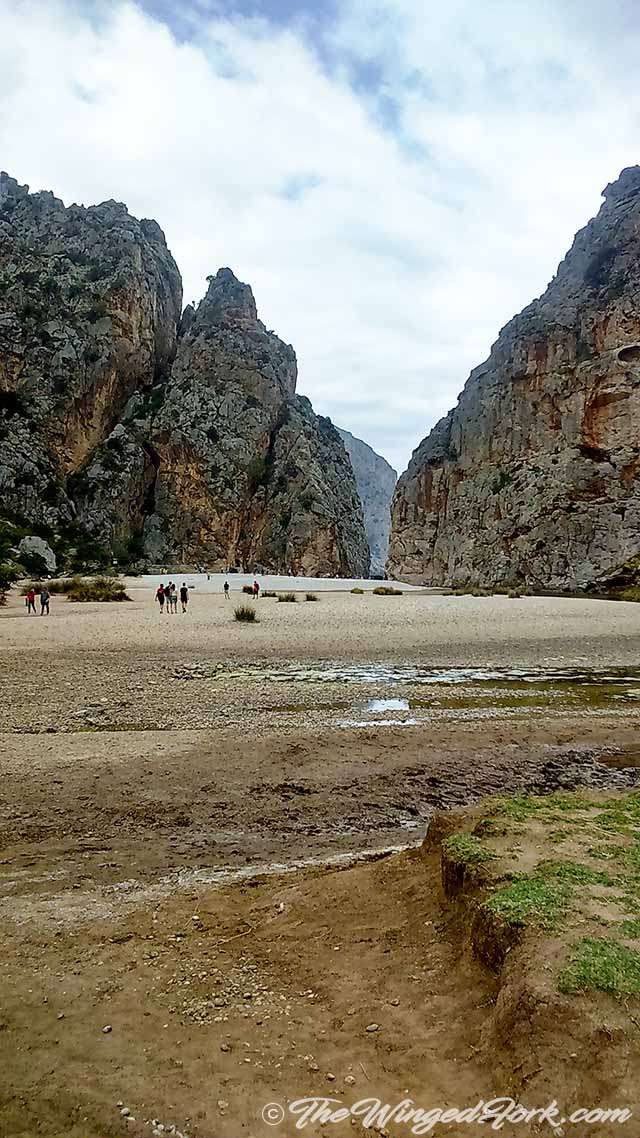
This UNESCO World Heritage Site is famous for its scenic beauty and sheer cliffs. It’s 5 kilometres long starting Lluc or Gorge Blau and passing through difficult passages take almost more than half a day to complete. But the reward if coming downhill is the beautiful Sa Calobra at the end.

We didn’t hike the Torrent de Pareis, although my brother and his wife have a few times. But we did explore one end of it. Here’ sis, brother and sis-in-law exploring the holes in a rock. Can you spot all three of them?



And here’s them all busy taking pics.
Well, it is actually a great place to take pics. Isn’t it? The Torrent de Pareis is one of the top canyoning destinations in the world.

Just remember not to attempt crossing the Torrent de Pareis during the monsoon. Lives have been lost trying to swim through some flooded passages. Go here for details on what to expect and my sis-in-law’s trip report on Torrent de Pareis.
If you want to discover the stirring mountainous landscape of Mallorca without the need to hike, check out this amazing tour that includes a boat ride and a ride on a vintage wooden train.
Get stunning views of Pollenca from the Puig de Maria
Pollenca is a much-visited ancient town with stone architecture, lush countryside and a tourist friendly port. But the best views of this town are from up on the neighbouring hill that houses the Puig de Maria or the Santuari de la Mare de Déu del Puig.

We parked in Pollenca and then walked to the foot of the Puig de Maria. The path up is sometimes tarred, sometimes covered with cobblestones. But all the way up you can smell the surrounding pine trees.
Try to go there before 10 am to avoid the crowds though. It gets really crowded around mid day and looks like a pilgrimage going uphill.
There was a celebration going on in one of the rooms of the Puig de Maria with people singing loudly. Once we saw the tiny museum at the top of the Puig, we enjoyed our ice creams from the restaurant.

We also got some great birds-eye view shots of Pollenca from up there. It’s easy to spot the Claustre de San Domingo, Santa Maria des Angels and the Esglesias de Montes-Sion.
Visit the Cuevas del Drach caves containing an underground lake
Discovered well before the 13th century, these 4 large underground caves have brilliant formations of stalactites and stalagmites. Some even see the shape of Santa Claus in one of them. These caves have been mentioned in Jules Vernes book ‘Clovis Dartetor’.
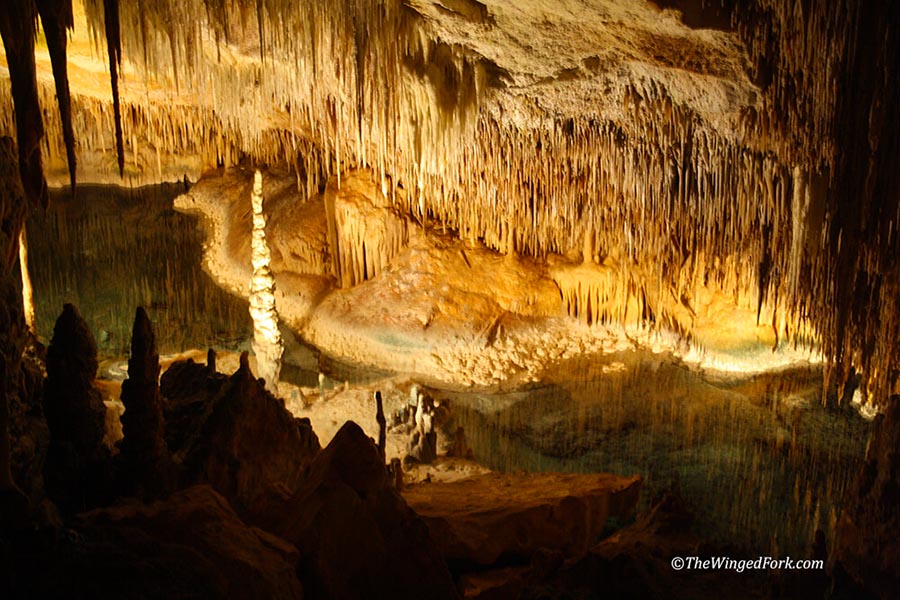
They’re not as big as the lake in Seegrotee Hinterbruhl, but amazing all the same. There was a concert on Lake Martel at the end, post which we took a short boat ride across this underground lake. But you can read more about that in my brother’s post here.
Kayak along the Cala Blava coast line at Cap Rocat

There’s nothing that’s more fun than water sports. But when it comes to kayaking in Mallorca, you don’t just have beaches to follow.
If you follow a particular stretch from Cala Blava to Cap Rocat, you can kayak or paddle into and around a number of rocky coves. In some of these caves, the sound of the waves crashing against the rocks is all you can hear. Definitely one for the books! Read more about our eventful kayak trip here.
Eat a fish braai


Okay, I know this has nothing to do with Spain or Mallorca. But we enjoyed a yummy fish braai dinner while there. Sis-in-law is South African and made it for us topped with a yummy garlic cheese sauce. Fish and cheese, a combination that can never go wrong! Yummy yummy!
Get lost among the alleyways

Yeah, we got lost a few times and enjoyed it. It’s fun to walk unknown alleyways and admire the old architecture. Go do it!
Other Posts About Travel in Europe
- European Street Food You Can’t Miss
- Where to eat in Chania, Crete
- Cuevas del Drach in mallorca
- 13 Things you must do in Graz
- What to do in Feldkirch




I’m an East Indian foodie and travel blogger from Bombay, India. I’ve travelled across parts of Europe and Asia, and love writing about my experiences with people and cultures. And naturally, I love food, wine, and travel, and have an endless bucket list of places to go to, and experiences I must blog about.
I also love baking and experimenting with food, with a little help from my family. If you must know, my favorite things are nice rainy days, the smell of cakes in the oven, playing in the snow, glasses of wine, and dark chocolate.
More info about me here!



